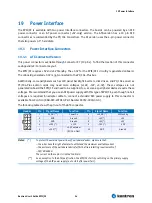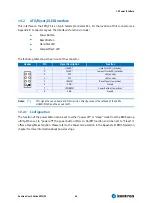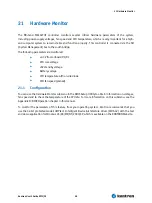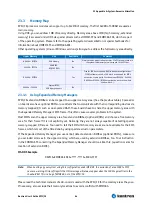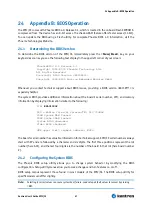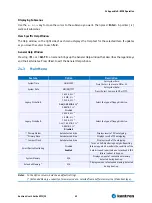
23 Appendix A: System-Resource Allocation
Kontron User's Guide EPIC/CE
64
23.3
Memory Map
EPIC/CE processor modules can support up to 512MB of memory. The first 640KB of SDRAM are used as
main memory.
Using DOS, you can address 1MB of memory directly. Memory area above 1MB (high memory, extended
memory) is accessed under DOS via special drivers such as HIMEM.SYS and EMM386.EXE, which are part
of the operating system. Please refer to the operating system documentation or special textbooks for
information about HIMEM.SYS and EMM386.EXE.
Other operating systems (Linux or Windows versions) allow you to address the full memory area directly.
Upper Memory
Use
Available
Comment
A0000h – BFFFFh
VGA Memory
No
Mainly used by graphic adapter cards. If a PCI graphic card is in
the system this memory area is mapped to the PCI bus.
C0000h – CFFFFh
VGA BIOS,
RPL/PXE ROM
No
D0000h – DFFFFh
Yes
Free for ISA bus or shadow RAM in standard configurations.
If JRC software is used, a 16K block is shadowed for BIOS
extension, starting with first free area at D0000h, D4000h,
D8000hor DC000h. (BIOS extensions do not use the whole
shadow block.).
E0000h – F0000h
System BIOS,
USB legacy support
No
23.3.1
Using Expanded Memory Managers
EPIC/CE extension BIOSes can be mapped to an upper memory area. (See the previous table.) Some add-
on boards also have optional ROMs or use drivers that communicate with their corresponding devices via
memory mapped I/O such as dual-ported RAM. These boards have to share the upper memory area with
the Expanded Memory Manager’s EMS frame. This often causes several problems in the system.
Most EMMs scan the upper memory area for extension BIOSes (optional ROMs) and choose a free memory
area for their frame if it is not explicitly set. Normally, they are not always capable of detecting special
memory-mapped I/O areas. You need to tell the EMM which memory areas are not available for the EMS
frames, which is most of the time done by using special exclusion parameters.
If the Expanded Memory Manager you use cannot detect extension BIOSes (optional ROMs), make sure
you excluded all areas in the upper memory, which are used by extension BIOSes, too. Your instruction
in the CONFIG.SYS concerning the Expanded Memory Manager should look like this: (question marks for
location of extension BIOS).
MS-DOS Example
DEVICE=EMM386.EXE
X=????-????
X=E000-FFFF
Note
:
When booting up your system using this configuration under MS-DOS, the exclusion of area F000 to FFFF
causes a warning. Microsoft reports that this message will always appear when the F000 segment lies in the
shadow RAM. This is a bug of EMM386, not of the EPIC/CE.
Please read the technical manuals of add-on cards used with the EPIC/CE for the memory areas they use.
If necessary, also exclude their memory locations to avoid a conflict with EMM386.
Summary of Contents for EPIC/CE
Page 1: ...Kontron User s Guide EPIC CE Document Revision 1 14...
Page 2: ...This page intentionally left blank...
Page 88: ...25 Appendix C Block Diagram Kontron User s Guide EPIC CE 88 25 Appendix C Block Diagram...
Page 93: ...27 Appendix E Connector Layout Kontron User s Guide EPIC CE 93 27 2 Bottom Side...





